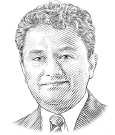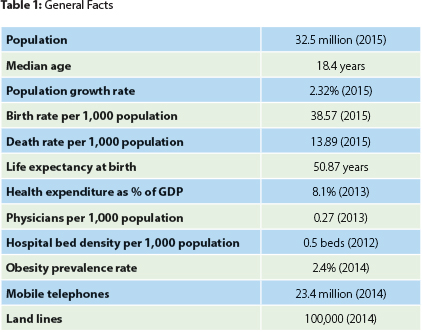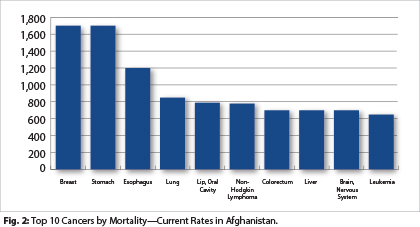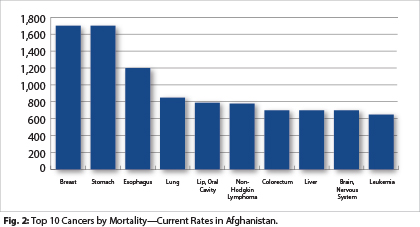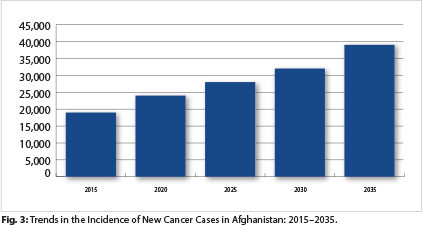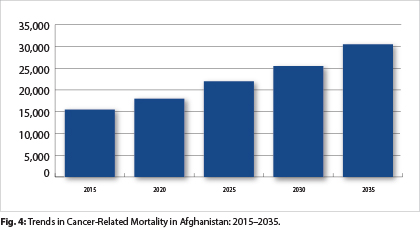The ASCO Post is pleased to introduce this special focus on the worldwide cancer burden, beginning in this issue with a close look at the cancer incidence and mortality rates in the United States. The aim of this special feature is to highlight the global cancer burden for various countries of the world. For the convenience of the reader, each issue will focus on one country from one of the six regions of the world as defined by the World Health Organization (ie, Africa, the Americas, South-East Asia, Europe, Eastern Mediterranean, and Western Pacific). Each section will focus on the general aspects of the country followed the current and predicted rates of incidence and cancer-related mortality. It is hoped that through these issues, we can increase awareness and shift public policy and funds toward proactively addressing this lethal disease on the global stage.
Disclaimer: is commentary represents the views of the author and may not necessarily re ect the views of ASCO.
Afghanistan, with a population of nearly 32.5 million, is the 41st most populous nation in the world. The median age is very young, at 18.4 years, with a high population growth rate of 2.32% (34th in the world), a high birth rate of 38.57/1,000 population (11th in the world), and an even higher death rate of 13.89 deaths/100,000 population (9th in the world). This contributes to a very low life expectancy of 51 years (222nd rank in the world). Although Afghanistan spends nearly 8.5% of its gross domestic product on health care (ranked 46th in the world), this does not seem to translate to real benefits. The physician density of 0.27 physicians/1,000 population and the hospital bed density of 0.5 beds/1,000 population stand in stark contrast to the figures in the United States of 2.45 physicians/1,000 population and 2.9 beds/1,000 population, respectively.
The cancer profile in Afghanistan is very different from the profile in high-income countries such as the United States. The most common cancers seen in Afghanistan by incidence include breast, stomach, esophagus, and lip/oral cavity. Cancers of the breast, stomach, esophagus, and lungs contribute the most to cancer-related mortality in this country.
In addition, although the overall incidence may seem low, the overall cancer-related mortality is very high when compared with the overall incidence. For example, in the year 2015, there were 19,656 new cancer cases and 15,211 cancer-related deaths in Afghanistan, accounting for nearly 78% of the incidence. In contrast, for the United States in 2015, there were 1,730,861 new cancer cases and 667,333 cancer-related death, accounting for 38% of the incidence.
There are several issues associated with cancer care in Afghanistan. The primary one consists of the unavailability of accurate data on the actual burden of cancer. Some of the data obtained from GLOBOCAN is not directly from Afghanistan but based on extrapolation from data from neighboring countries. There is no national cancer policy or action plan, and similarly there is a lack of robust cancer registries. Screening for early detection of breast, cervical, and colorectal cancers is not generally available at the public primary health-care level. Similarly, radiotherapy or chemotherapy is universally unavailable at the public primary health-care level. Although some facilities existed in the past, the intervening war years destroyed most facilities capable of treating patients with cancer. As a result, many patients travel outside the country to receive cancer care.
Efforts are underway to address the rising cancer burden. The first world cancer day in Afghanistan was held on February 6, 2013, in Kabul to express commitment and dedication to improve health status as well as to reduce mortality and morbidity—not only of communicable diseases but also noncommunicable diseases such as cancer. A national strategy (2013–2018) for prevention and control of noncommunicable diseases underscores the importance placed on control of diseases such as cancer. Recent attempts are underway in conjunction with the International Atomic Energy Agency to open a radiotherapy facility to re-establish cancer care in Kabul. Cancer is blind to war and peace and strikes just as hard in conflict-free and conflict-ridden zones of the world. It is hoped that through these efforts and resolution of conflict, appropriate measures can be taken to deliver compassionate and timely cancer care to these patients in dire need. ■
Additional Readings
1. http://www.who.int/nmh/countries/afg_en.pdf
2. http://www.emro.who.int/afg/afghanistan-news/world-cancer-day-2013.html
3. http://www.who.int/nmh/ncd-tools/en/
4. https://www.iaea.org/newscenter/news/world-cancer-day-afghanistan-looks-open- cancer-care-centre
GUEST EDITOR
Dr. Are is Jerald L & Carolynn J. Varner Professor of Surgical Oncology & Global Health, Vice Chair of Education, Program Director, General Surgery Residency, University of Nebraska Medical Center, Omaha.
Note to Readers: If you are interested in participating in this continuing series on the global cancer burden and have an interesting perspective to share about a particular region of the world, contact Dr. Are at care@unmc.edu.

